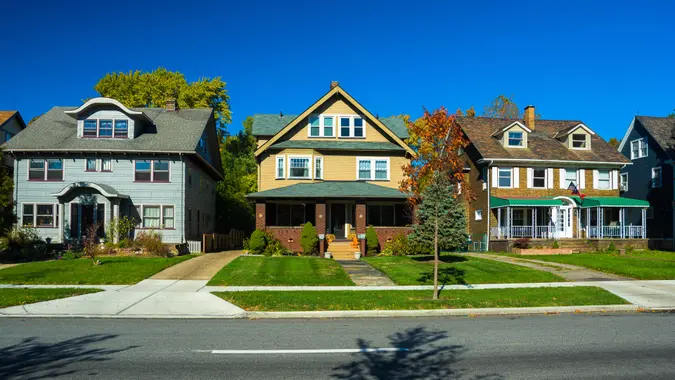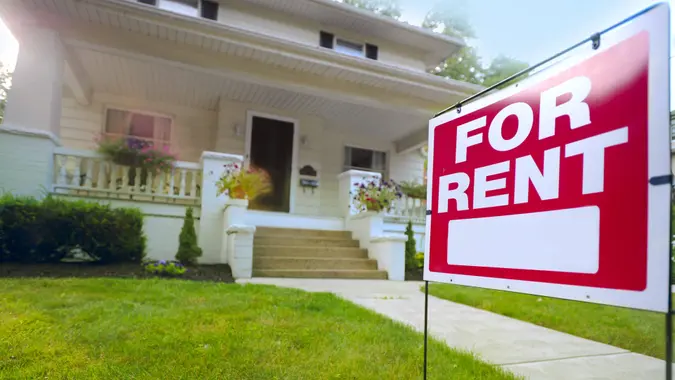I’m a Real Estate Agent: 6 Types of Homes I Won’t Even Show My Frugal Clients

Commitment to Our Readers
GOBankingRates' editorial team is committed to bringing you unbiased reviews and information. We use data-driven methodologies to evaluate financial products and services - our reviews and ratings are not influenced by advertisers. You can read more about our editorial guidelines and our products and services review methodology.

20 Years
Helping You Live Richer

Reviewed
by Experts

Trusted by
Millions of Readers
Mike Wall is a real estate agent and the owner of EZ Sell Homebuyers, a property investment company in Dayton, Ohio. Over the decades, he’s learned to spot listings that aren’t even worth showing to penny-pinching buyers.
“In my 23 years as a real estate agent, with over 1,700 homes sold, I’ve developed a keen insight into the preferences of various buyer segments, especially the most frugal ones,” said Wall. “These budget-conscious buyers are characterized by their meticulous approach to purchasing a home, prioritizing long-term value, affordability, and maintenance costs over immediate aesthetics or trends. From my extensive experience, I’ve identified several types of homes frugal buyers typically avoid and the reasons behind their decisions.”
Large, Older Homes
Houses that have endured many decades have unique personalities and interesting histories that you won’t find in newer builds. But decades are unkind to building materials, electrical wiring, appliances, and mechanical systems — and thrifty buyers know that none of that is cheap to replace.
“While the charm and character of older homes can be appealing, frugal buyers often shy away from them, especially if they’re large,” said Wall. “The main concerns here are the high maintenance costs and energy inefficiency. Older homes often require significant heating, plumbing, and electrical updates. Additionally, the cost to heat or cool large spaces can be prohibitive, making these homes less attractive to those looking to maximize their investment.”
Homes With Swimming Pools
According to HGTV, an in-ground pool can add 5% to 8% to a home’s value — that’s $20,000-$32,000 on a $400,000 house. But even so, a big cement hole filled with water in the backyard is what Wall calls a “hard pass” for frugal buyers.
“The reasons are twofold,” he said. “The upfront cost and ongoing maintenance expenses. Pools require regular cleaning, chemical balancing, and sometimes expensive repairs, not to mention the increased liability insurance costs. When assessing the overall value, frugal buyers typically conclude that the costs outweigh the benefits.”
Fixer-Uppers Requiring Extensive Renovations
Phrases like “a little TLC” send frugal buyers running away from listings — especially when it appears that a little is likely to become a lot.
“While fixer-uppers appeal to some buyers looking to put their stamp on a property, they often deter frugal buyers who are wary of the hidden costs associated with renovations,” said Wall. “Projects often exceed initial budgets and timelines, and unexpected issues can arise, leading to further expenses. Frugal buyers prefer move-in ready homes or requiring minimal updates to avoid the financial risk and potential stress involved in extensive renovations.”
Homes in High-Tax Areas or With High HOA Fees
Location is always a key factor in real estate, and frugal buyers pay close attention to what the municipality and housing authorities will charge them to live in a certain place.
“Homes in areas with high property taxes or substantial HOA fees can significantly add to the monthly homeownership cost,” said Wall. “These ongoing expenses can quickly make a home unaffordable for budget-conscious buyers, leading them to look for properties in more tax-friendly locales or communities with lower or no HOA fees.”
Trendy or Overly Customized Homes
Consultants steer sellers toward neutral tones and away from quirky decor or distracting features for good reason.“Homes that have been heavily customized to the owner’s unique tastes or those that adhere strictly to the latest trends often do not appeal to frugal buyers,” said Wall. “The concern here is the potential difficulty in reselling the home in the future without making costly modifications. Frugal buyers prefer homes with more neutral, timeless appeal that can easily adapt to various tastes and styles.”
Anything Impractical
In the end, thrifty homebuyers approach real estate purchases the same way they approach their grocery list or a trip to the hardware store — they want to get the most bang for their buck with as few surprises as possible.
“Frugal buyers are highly pragmatic in their approach to purchasing a home,” said Wall. “They prioritize efficiency, functionality and the long-term financial implications of their investment. Understanding the types of homes they typically avoid can help sellers and real estate professionals better prepare their properties for the market, ensuring they appeal to the broadest range of potential buyers, including the most budget-conscious ones.”
 Written by
Written by  Edited by
Edited by 

























